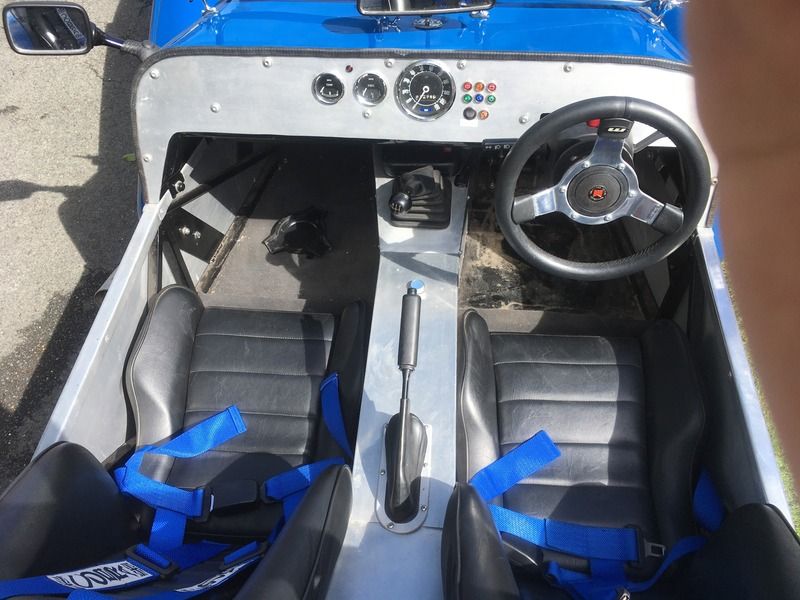It's 1300 crossflow, I'm trying to figure out how to upload pictures
Cheers

[Edited on 17/8/18 by thelynxeffect]

Hi guys, this is my first post so I should apologise for it being a question, I need to monitor the state of my battery and the charge it is
receiving, should I be considering a volt meter (voltage would increase when engine is running) or an Amp meter so I can see the charge current?
Either way it needs to be a chromed smiths gauge to match the dash.
It's 1300 crossflow, I'm trying to figure out how to upload pictures
Cheers

[Edited on 17/8/18 by thelynxeffect]
Welcome. As regards ammeter vs voltmeter an amp meter will show the rate of charge or discharge but will not show if the battery voltage is low whereas a voltmeter will show charging voltage when running and static battery voltage when not running. At least that's the way I see it .Personally I would go for a voltmeter.
as above,
ammeter will show if its charging,
it will not show the current taken when starting - this is because it would be way off the scale. (has to be wired in the battery feed, but after the
starter takeoff )
for an overall battery charge level indicator, volts is best.
but make sure its on the ignition live side of the circuits. (directly across the battery will give a small continuous load)
oh, and WELCOME
Thanks guys, that’s just the sort of answers I was looking for!
Were not amp meters predominately fitted to dynamos and voltmeters fitted to alternators ?
Does the voltmeter feed need to be fused?
quote:it should be. of course it will work without, but fuses are there for protection. it doesn't matter if the volt meter stops, (and indirectly indicates a fault), much preferred to melting the wiring loom...
Originally posted by thelynxeffect
Does the voltmeter feed need to be fused?
No need for a fuse. No reason you can't fit both, voltmeter will tell you how charged or discharged your battery is, ammeter will tell you how much current is charging it. Both are useful.
quote:
Originally posted by Mr Whippy
No need for a fuse. No reason you can't fit both, voltmeter will tell you how charged or discharged your battery is, ammeter will tell you how much current is charging it. Both are useful.

Welcome to the site...
Should you need more reasons to install voltmeter, Amp meters usually require larger gage cable as more current is involved whereas Voltmeters
require smaller gage cable.
Also agree to install fuse in circuit.
HTH
Welcome.
Just BTTT, Why MUST you monitor them? Do you suspect a problem?
Valid question, I have space for a 2” gauge and voltmeter seemed a logical option, either that or I squeeze in a rev counter
quote:clock, (you know that thing that tells the time!)
Originally posted by thelynxeffect
Valid question, I have space for a 2” gauge and voltmeter seemed a logical option, either that or I squeeze in a rev counter
.....and nice motor too Matey 
Welcome 
quote:
Originally posted by thelynxeffect
Valid question, I have space for a 2” gauge and voltmeter seemed a logical option, either that or I squeeze in a rev counter
I wouldn’t want 40+ Amps under the dash unless the wiring was fully sealed and properly insulated and clipped, even then....
Thanks again, I'm not exactly short on space so I think I'll fit a voltmeter and probably a Rev counter also, just a case of waiting for the
right ones on the bay now.
Thanks for all you advise, I'll post the results once fitted.

A pair of rubber mats wouldn't go a miss, soft alloy floors wear quite quickly and are as slippy as hell if damp, wet or covered in sand
Nice car though
quote:
Originally posted by snapper
I wouldn’t want 40+ Amps under the dash unless the wiring was fully sealed and properly insulated and clipped, even then....
quote:
Originally posted by Mr Whippy
A pair of rubber mats wouldn't go a miss, soft alloy floors wear quite quickly and are as slippy as hell if damp, wet or covered in sand
Nice car though